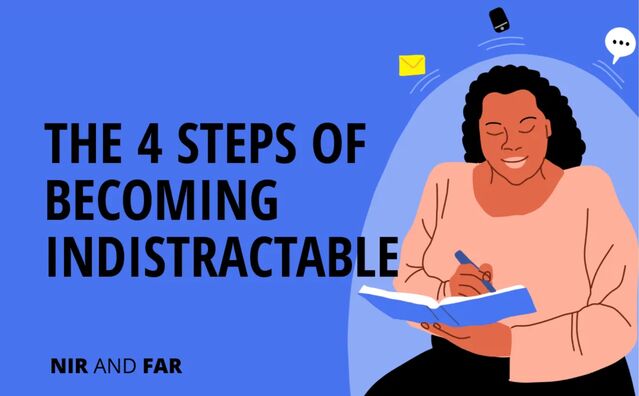Attention
The 4 Steps to Becoming Indistractable
Here’s how to manage your wandering mind.
Posted July 24, 2022 Reviewed by Jessica Schrader
Key points
- Distraction can erode one’s day-to-day life and divert their resources toward things that don’t really matter.
- Four pillars to becoming indistractable include mastering internal triggers, making time for traction, and hacking back external triggers.
- Making time for the things you really want to do is important.

Overcoming distraction is the struggle of our time. Here’s how to manage your wandering mind.

Every building needs a sturdy foundation. Your daily habits are a foundation on which you are building who you are—your values, goals, personality, etc.
If you track your daily habits, you may be surprised to find a collection of suboptimal habits: you may not be reaching your full potential.
One of those suboptimal habits is being easily distracted.
Distraction erodes your day-to-day life and diverts your resources toward things that don’t really matter. If you’re not equipped to manage distraction—if you’re not indistractable—your brain will be manipulated by time-wasting diversions.
There are four pillars to becoming indistractable:
- Mastering internal triggers
- Making time for traction
- Hacking back external triggers
- Blocking out distraction
Before we explore each pillar, we must first have an understanding of internal and external triggers.
Imagine a line that represents the value of everything you do throughout your day. To the right, the actions are positive; to the left, they are negative. The positive actions represent traction: they draw or pull us toward what we want in life. The word “traction,” in fact, comes from the Latin trahere, meaning to draw or pull. The negative actions represent distraction—the opposite of traction. Distractions are things that push us away from what we want most in life.

All behaviors, both traction and distraction, are prompted by triggers, both internal and external.
Internal triggers cue us from within. When we feel our belly growl, we look for a snack. When we’re cold, we find a coat to warm up. And when we’re sad, lonely, or stressed, we might call a friend or loved one for support.
External triggers, on the other hand, are cues in our environment such as the pings, dings, and rings that prompt us to check our email, answer a phone call, or open a news alert. External triggers can also take the form of other people, such as a co-worker who stops by our desk to chat. They can also be objects, like a television set whose mere presence urges us to turn it on.
Whether it’s an internal or an external trigger that prompts us, the resulting action is either aligned with our broader intention (traction), or misaligned (distraction). Traction moves us toward our goals; distraction moves us away from them.
Now that we have an understanding of internal and external triggers, let’s examine each of the four pillars of becoming indistractable.
1. Mastering Internal Triggers
The first step to managing distraction is to recognize that it starts from within. Unless we deal with the root causes of distraction, we will continue to find ways to distract ourselves.
Distraction, it turns out, isn’t about the distracting thing itself; rather, it’s about how we respond to it.
Resisting, ruminating, and finally giving in to the desire perpetuates the cycle of distraction and quite possibly drives many unwanted behaviors.
While we can’t control the feelings and thoughts that pop into our heads, we can control what we do with them. We can manage distractions that originate from within by changing how we think about them. We can reimagine the trigger, the task, and our temperament. Rather than trying to fight the urge, we need new methods to handle intrusive thoughts.
The following four steps help us do just that:
Step 1: Look for the discomfort that precedes the distraction, focusing in on the internal trigger.
Step 2: Write down the trigger.
Step 3: Explore your negative sensations with curiosity instead of contempt.
Step 4: Be extra cautious during liminal moments when you transition from one activity to another.
Reimagining the internal trigger, the task, and our temperament are powerful and proven ways to deal with distractions that start within us. We can cope with uncomfortable internal triggers by reflecting on, rather than reacting to, our discomfort. We can reimagine the task we are trying to accomplish by looking for the fun in it and focusing on it more intensely.
Finally, and most importantly, we can change the way we see ourselves to get rid of self-limiting beliefs. If we believe we’re short on willpower and self-control, then we will be. If we decide we’re powerless to resist temptation, it becomes true. If we tell ourselves we are deficient by nature, we will believe every word.
2. Making Time for Traction
Making time for the things you really want to do is important. You can’t call something a “distraction” unless you know what it is distracting you from.
Three domains comprise the people with whom we spend our time: work, relationships, and you. They give us a way to think about how we plan our days so that we can become the people we really want to be.
Being indistractable is largely about making sure you make time for traction each day and eliminating the distraction that keeps you from living the life you want—one that involves taking care of yourself, your relationships, and your work.
Planning your time with intention is critical, even if you choose to spend it scrolling through celebrity headlines or reading a steamy romance novel. After all, the time you’ve planned to waste is not wasted time.
By defining how we spend our time and syncing with the stakeholders in our lives, we ensure that we do the things that matter and ignore the things that don’t.
It frees us from the trivialities of our day and gives us back the time we can’t afford to waste.
3. Hacking Back External Triggers
Unwanted external triggers hamper our productivity and diminish our well-being. While technology companies use cues like the pings and dings on our phones to hack our behavior, external triggers are not confined to our digital devices. They’re all around us—from cookies beckoning when we open the kitchen cabinet to a chatty co-worker keeping us from finishing a time-sensitive project.
Some of the top distractions include:
- Work interruptions
- Group chat
- Meetings
- Smartphone
- Computer desktop
- Online articles
- Online feeds
These interruptions lead to mistakes and steal your time from what you should be focused on. It’s time to block out those distractions.
Answer the question: Is this trigger serving me, or am I serving it? That way, you can hack back the external triggers that aren’t serving you.
4. Blocking Out Distraction
After we have learned to master internal triggers, make time for traction, and hack back external triggers, the last step to becoming indistractable involves preventing ourselves from sliding into distraction.
To do so, we must learn a powerful technique called “precommitment,” which involves removing a choice in the future to overcome our impulses in the present.
Precommitments are the last line of defense preventing us from sliding into distraction. You should only use this after the other three indistractable strategies have been applied.
Don’t skip the first three steps.
You can prevent distractions with effort pacts, which makes unwanted behavior more difficult to do. You can also make a price pact, which involves putting money on the line to encourage you to do what you say you will. Finally, an identity pact is one of the most effective ways of changing your behavior since it involves changing our identity—your image of who you are.
Whether you are trying to block out distractions in the workplace, raise indistractable kids, or foster indistractable relationships, you can regain lost productivity at work, have more satisfying relationships with your friends and family, and more—all by conquering distraction.
Your “home” will be built on a sturdy and lasting foundation that will allow you to live the best possible life.
This article also appeared on NirAndFar.com.




